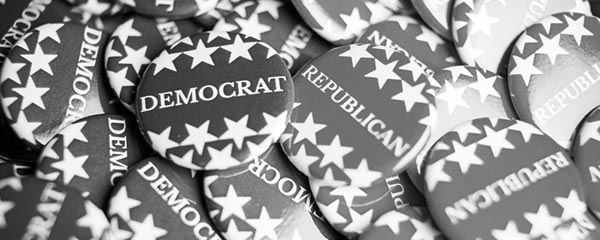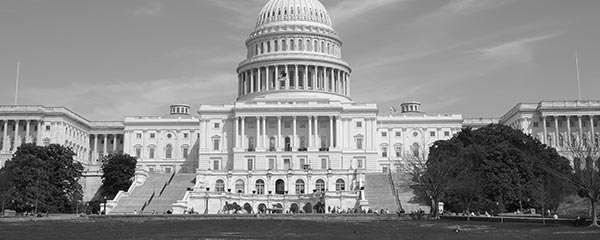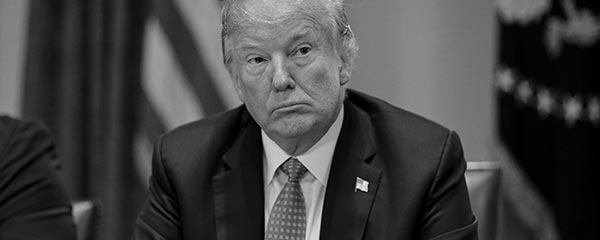Story Highlights
- Majority of adults feel more enthusiastic about voting this year than usual
- Enthusiasm is high among both party groups, matching GOP's 2010 level
- Republicans and Democrats much more certain to vote than independents
WASHINGTON, D.C. -- Americans' enthusiasm for voting in November is significantly higher than it was in the prior six midterm election years. Fifty-five percent of U.S. adults say they are "more enthusiastic" about voting than usual, which contrasts with between 37% and 50% saying the same in Gallup's final pre-election surveys each midterm year from 1994 through 2014. Currently, 33% say they are "less enthusiastic."
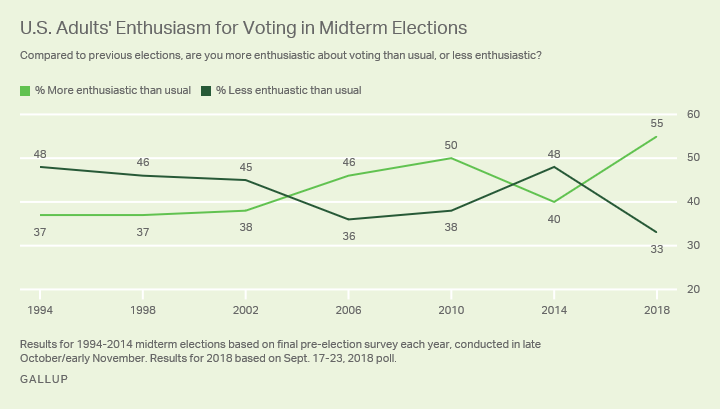
The latest results are based on Gallup polling conducted Sept. 17-23, as Congress has been holding hearings on President Donald Trump's nominee for the Supreme Court, Brett Kavanaugh.
Gallup's full midterm-election trend on voter enthusiasm -- including all measures taken prior to the final pre-election poll each year -- shows that voter enthusiasm was higher than today only once, in March 2010. At that time, shortly after Congress passed the Affordable Care Act, 61% of U.S. adults said they were more enthusiastic than usual about voting. This proved temporary, however, as it fell to 49% in May 2010 and was 50% at the time of the election.
More generally, it appears that public enthusiasm about voting settles in to its final pattern by the fall of election years. In all midterm years when Gallup asked the enthusiasm measure multiple times (1994, 1998, 2006, 2010 and 2014), the percentage feeling more enthusiastic than usual about voting either stayed the same or increased slightly between August or September and the final pre-election measure.
Both Party Groups' Enthusiasm for Voting Is at a Fever Pitch
Today's heightened enthusiasm is the result of high levels of enthusiasm among Republicans and Democrats -- possibly reflecting both party groups' enhanced recognition of the importance of the election in light of the high-stakes Kavanaugh hearings.
Sixty-one percent of Democrats and Democratic leaners and 58% of Republicans and Republican leaners say they are more enthusiastic about voting in November compared to prior elections. These levels roughly match Republicans' record-high enthusiasm in 2010, Barack Obama's first midterm, when the GOP won a whopping 63 seats. But this is the first time in Gallup's trend since 1994 that both parties have expressed high enthusiasm.
By contrast, the only two other times a majority of either party felt more enthusiastic than usual about voting, there was a partisan imbalance. In 2010, Republicans were far more likely than Democrats to be enthusiastic -- 63% vs. 44% -- and in 2006, Democrats were more likely than Republicans, 53% to 44%.
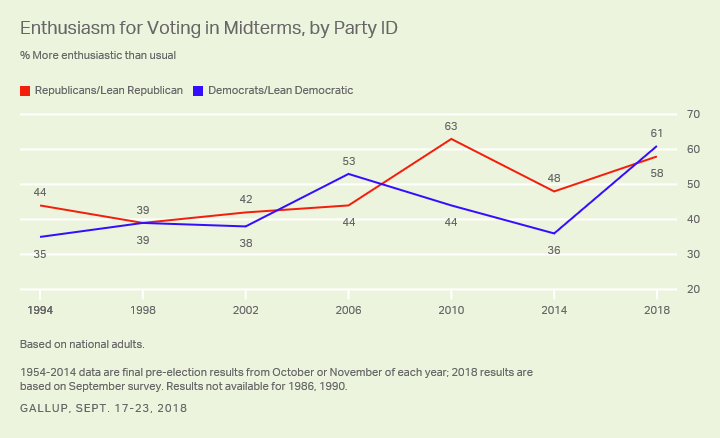
Gallup also recorded sizeable partisan gaps in enthusiasm in 1994 and 2014, but enthusiasm was relatively low among both party groups, resulting in low overall enthusiasm.
Certainty of Voting Is Flat
Today's heightened enthusiasm may not translate into higher turnout than in previous years, as a separate measure shows that Americans claim to be no more certain that they will vote in November than has been the case in previous elections.
Fifty-eight percent of U.S. adults describe themselves as absolutely certain they will vote. That is identical to Gallup's final measures in 2014 and 1998, but lower than in 1994, 2006 and 2010.
Today's level of certainty is consistent with Gallup's early pre-election trends, from 1954 to 1982.
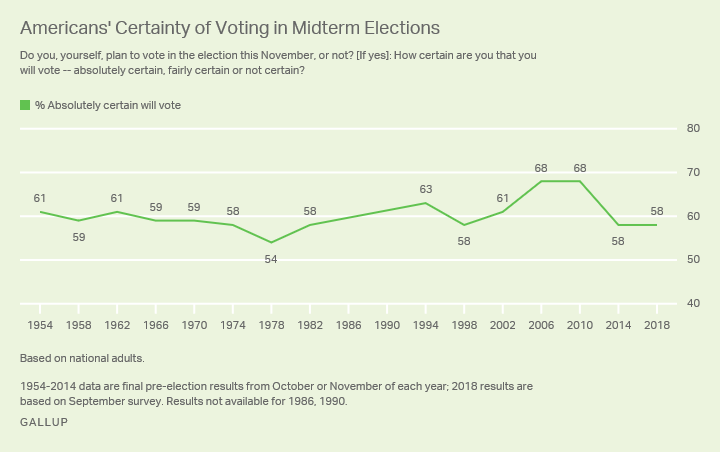
Still, Democrats and Republicans express a fairly high certainty of voting, with 72% and 70%, respectively, saying they are absolutely certain they will vote in November.
Overall certainty is suppressed by the low percentage of independents (43%) who are sure they will vote. This pattern is similar to 2014, perhaps reflecting independents' desire to opt out of today's polarized political environment. However, it differs from 1994 through 2010 when independents were closer to Republicans and Democrats in their certainty to vote.
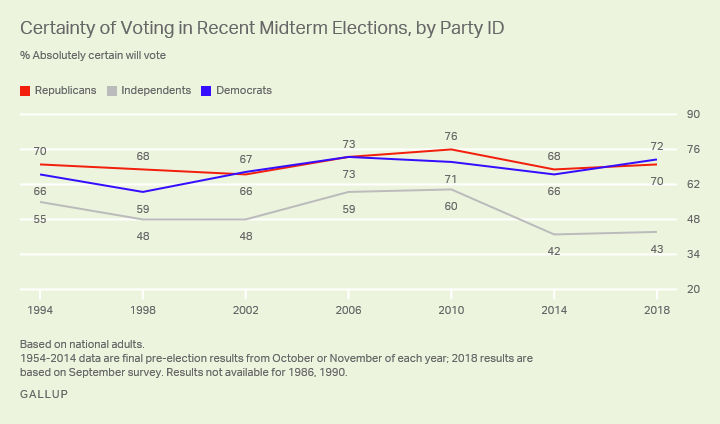
This year's parity in partisan intent to vote is similar to the figures in 2002, 2006 and 2014 -- years of either relatively modest seat change in Congress (2002 and 2014) or Democratic gains (2006).
In three years -- 1994, 1998 and 2010 -- Republicans were more likely than Democrats to be absolutely certain about voting. In two of those years, 1994 and 2010, Republicans enjoyed substantial seat gains, but in 1998 they underperformed, losing a small number of seats.
Voting Certainty and Enthusiasm Vary by Age and Race
Beyond the partisan patterns in voter certainty and enthusiasm -- with Republicans and Democrats appearing eager to have their say at the polls -- the new poll finds men and women expressing equal levels of enthusiasm and intent to participate in the election.
As is usual, however, there is a wide range in the responses to both questions by age, with older Americans being more enthusiastic and likely to vote. There is also a racial gap with non-Hispanic whites being more engaged with the election than non-whites.
| % Absolutely certain will vote | % More enthusiastic about voting | |||||||||||||||||||||||||||||||||||||||||||||||||||||||||||||||||||||||||||||||||||||||||||||||||||
|---|---|---|---|---|---|---|---|---|---|---|---|---|---|---|---|---|---|---|---|---|---|---|---|---|---|---|---|---|---|---|---|---|---|---|---|---|---|---|---|---|---|---|---|---|---|---|---|---|---|---|---|---|---|---|---|---|---|---|---|---|---|---|---|---|---|---|---|---|---|---|---|---|---|---|---|---|---|---|---|---|---|---|---|---|---|---|---|---|---|---|---|---|---|---|---|---|---|---|---|---|
| % | % | |||||||||||||||||||||||||||||||||||||||||||||||||||||||||||||||||||||||||||||||||||||||||||||||||||
| U.S. adults | 58 | 55 | ||||||||||||||||||||||||||||||||||||||||||||||||||||||||||||||||||||||||||||||||||||||||||||||||||
| Gender | ||||||||||||||||||||||||||||||||||||||||||||||||||||||||||||||||||||||||||||||||||||||||||||||||||||
| Men | 57 | 57 | ||||||||||||||||||||||||||||||||||||||||||||||||||||||||||||||||||||||||||||||||||||||||||||||||||
| Women | 60 | 53 | ||||||||||||||||||||||||||||||||||||||||||||||||||||||||||||||||||||||||||||||||||||||||||||||||||
| Age | ||||||||||||||||||||||||||||||||||||||||||||||||||||||||||||||||||||||||||||||||||||||||||||||||||||
| 18 to 29 | 26 | 44 | ||||||||||||||||||||||||||||||||||||||||||||||||||||||||||||||||||||||||||||||||||||||||||||||||||
| 30 to 49 | 55 | 52 | ||||||||||||||||||||||||||||||||||||||||||||||||||||||||||||||||||||||||||||||||||||||||||||||||||
| 50 to 64 | 69 | 59 | ||||||||||||||||||||||||||||||||||||||||||||||||||||||||||||||||||||||||||||||||||||||||||||||||||
| 65 and older | 82 | 65 | ||||||||||||||||||||||||||||||||||||||||||||||||||||||||||||||||||||||||||||||||||||||||||||||||||
| Race/Ethnicity | ||||||||||||||||||||||||||||||||||||||||||||||||||||||||||||||||||||||||||||||||||||||||||||||||||||
| Non-Hispanic whites | 65 | 58 | ||||||||||||||||||||||||||||||||||||||||||||||||||||||||||||||||||||||||||||||||||||||||||||||||||
| Total nonwhites | 45 | 48 | ||||||||||||||||||||||||||||||||||||||||||||||||||||||||||||||||||||||||||||||||||||||||||||||||||
| Blacks | 66 | 50 | ||||||||||||||||||||||||||||||||||||||||||||||||||||||||||||||||||||||||||||||||||||||||||||||||||
| Hispanics | 27 | 47 | ||||||||||||||||||||||||||||||||||||||||||||||||||||||||||||||||||||||||||||||||||||||||||||||||||
| Party ID | ||||||||||||||||||||||||||||||||||||||||||||||||||||||||||||||||||||||||||||||||||||||||||||||||||||
| Democrats | 72 | 66 | ||||||||||||||||||||||||||||||||||||||||||||||||||||||||||||||||||||||||||||||||||||||||||||||||||
| Independents | 43 | 42 | ||||||||||||||||||||||||||||||||||||||||||||||||||||||||||||||||||||||||||||||||||||||||||||||||||
| Republicans | 70 | 64 | ||||||||||||||||||||||||||||||||||||||||||||||||||||||||||||||||||||||||||||||||||||||||||||||||||
| Leaned Party ID | ||||||||||||||||||||||||||||||||||||||||||||||||||||||||||||||||||||||||||||||||||||||||||||||||||||
| Democrats/Dem. leaners | 63 | 61 | ||||||||||||||||||||||||||||||||||||||||||||||||||||||||||||||||||||||||||||||||||||||||||||||||||
| Republicans/Rep. leaners | 65 | 58 | ||||||||||||||||||||||||||||||||||||||||||||||||||||||||||||||||||||||||||||||||||||||||||||||||||
| Gallup, Sept. 17-23, 2018 | ||||||||||||||||||||||||||||||||||||||||||||||||||||||||||||||||||||||||||||||||||||||||||||||||||||
Registered Voters Tilt Toward Voting Democratic in Their District
According to the generic congressional ballot updated on the current poll, 51% of registered voters prefer the Democratic candidate in their district while 42% favor the Republican. That nine-point lead for the Democrats exceeds the five-point advantage they held on this measure in June.
This modest change in the overall ballot masks a significant change by gender since June. Among registered voters, men have shifted from being split at 45% voting Democratic and 44% Republican in June, to tilting Republican by a six-point margin, 50% to 44%. At the same time, women's preference for Democratic candidates has widened from an eight-point margin in June -- 51% Democratic and 43% Republican -- to a 24-point lead today, 58% vs. 34%.
Bottom Line
Less than two months away from the November midterm elections, Republicans and Democrats are expressing equal levels of intent to vote as well as comparably high levels of enthusiasm about the election. This surge of enthusiasm may partly reflect partisans' response to the Kavanaugh hearings, just as passage of the Affordable Care Act in 2010 seemed to stimulate both parties' eagerness to vote. However, it remains to be seen whether that enthusiasm remains high, or quickly subsides once the Kavanaugh news tapers off, as it did in 2010 with the ACA.
Gallup's enthusiasm measure has historically been less related to voter turnout and more to the outcome of elections, possibly because the public can sense which party is ahead. Republicans had double-digit seat gains in years when they had a decided advantage in voter enthusiasm (1994, 2010 and 2014). By contrast, in 2006 the Democrats gained seats when they had the enthusiasm edge. In the two recent midterm years when the parties were at parity on enthusiasm, 1998 and 2002, there was relatively little seat change. While that's not great news for the Democrats given today's parity, their lead on the generic ballot is more promising. It's possible the two indicators will converge as the election nears, either with Democrats establishing a lead on enthusiasm or Republicans narrowing the gap on the generic ballot.
Editor's Note: This story has been updated; a previous version had incorrect percentages for the generic ballot by gender, as well as for certainty to vote by party ID.
View complete question responses and trends.
Learn more about how the Gallup U.S. Poll works.

